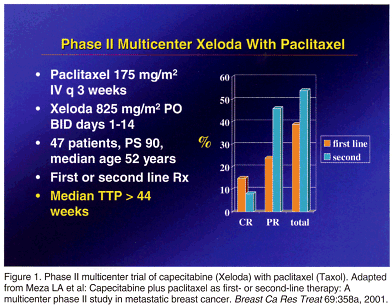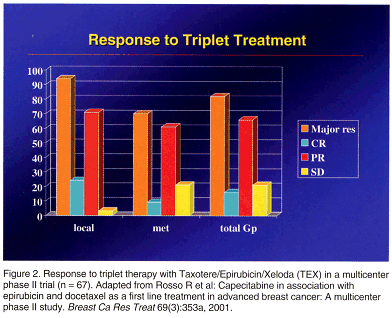Capecitabine Research Points to New Combinations for Metastatic Breast Cancer
MANHASSET, New York-Early clinical results suggest that capecitabine (Xeloda) may work well in several new combinations for metastatic breast cancer, according to Daniel R. Budman, MD, professor of medicine at New York University and associate director of medical oncology at North Shore University Hospital, Manhasset, New York
MANHASSET, New YorkEarly clinical results suggest that capecitabine (Xeloda) may work well in several new combinations for metastatic breast cancer, according to Daniel R. Budman, MD, professor of medicine at New York University and associate director of medical oncology at North Shore University Hospital, Manhasset, New York.
Beyond its successful pairing with docetaxel (Taxotere), capecitabine may have potential in combination with paclitaxel (Taxol), vinorelbine (Navelbine), irinotecan (CPT-11, Camptosar), and in triplet therapy with docetaxel and epirubicin (Ellence).
Speaking at an industry-sponsored symposium held in conjunction with the 38th Annual Meeting of the American Society of Clinical Oncology, Dr. Budman said that the docetaxel/capecitabine experience suggests several new directions for combination therapy, including different schedules of giving docetaxel and substituting a different taxane, such as paclitaxel (Taxol).
In a 47-patient phase II study of paclitaxel (175 mg/m² on day 1 every 3 weeks) and capecitabine (825 mg/m² twice a day on days 1 to 14), the median time to progression was more than 44 weeks, and the total response rate was nearly 40% when given as first-line therapy and more than 50% as second-line therapy (see Figure 1).

In another approach, capecitabine is being studied in combination with vinorelbine. Results of three small phase I or II trials indicate overall response rates around 50%.
In one study of 36 women age 65 or olderthe Swiss SAKK 25/99 trialall patients received, as first-line therapy, 20 mg/m² of vinorelbine on days 1 and 8, but the capecitabine dose varied from 800 mg/m² to 1,250 mg/m² twice daily on days 1 to 14. Dose-limiting toxicities were neutropenia, stomatitis, diarrhea, and thrombosis (Hess DD et al: Proc Am Assoc Clin Oncol 21(part 2):247b, 2002, abstract 2915).
"Antitumor responses were seen at all dosage levels," Dr. Budman said. "This brings up a different point because all of us try to use next to the maximum tolerated dose. But if you can get true synergism, it’s entirely conceivablealthough we haven’t really clinically studied it up frontto see whether we can give a relatively less toxic combination and yet get the same activity, which then becomes a major quality-of-life advantage."
Irinotecan for Breast Cancer
Dr. Budman’s group at North Shore University Hospital is conducting a phase I trial of irinotecan and capecitabine. They based their study on a phase II trial of irinotecan alone that achieved a 29% response rate among women with anthracycline- or taxane-treated metastatic breast cancer and on results from a colorectal cancer xenograft model showing clear synergismand even some cureswith irinotecan followed, after a 24-hour delay, with capecitabine.
In the phase I trial (abstract 2127), which now has 19 patients, the patients receive irinotecan (100 mg/m² on days 1 and 15 in a 28-day cycle) and capecitabine at doses ranging from 500 mg/m² bid to 1,250 mg/m² bid on days 2 to 8 and 16 to 22.
No grade 3 toxicities have been seen at the twice-daily capecitabine dose of 500 mg/m². Some fatigue, nausea, and vomiting have occurred at a twice-daily dose of 750 mg/m²; diarrhea, vomiting, and vertigo at 1,000 mg/m² twice daily; and abdominal pain at 1,250 mg/m² twice daily. All toxicities except abdominal pain involved compliance issues. "We’ve seen activity at all dose levels, Dr. Budman said. "We don’t have a maximum tolerated dose, but we may decide that will be related to leukopenia at day 8 with minimal gastrointestinal toxicity."
TEX: Ready for Prime Time?
The so-called TEX combinationTaxotere/Epirubicin/Xelodais based on documented preclinical synergy between docetaxel and epirubicin. A multicenter phase II Italian trial is evaluating the triplet in a 21-day regimen of capecitabine 500 mg/m² bid for 14 days, 75 mg/m² of docetaxel on day 1, and 75 mg/m² of epirubicin on day 1.
Inclusion criteria are as follows: locally advanced or measurable metastatic disease, age 18 to 70, ECOG performance status of 0 to 2, and no prior therapy for metastatic disease. Exclusion criteria are prior docetaxel, prior doxorubicin (Adriamycin) at a dose greater than 240 mg/m², prior epirubicin at a dose greater than 480 mg/m², prior mitoxantrone (Novantrone) at a dose greater than 70 mg/m², anthracyclines within 6 months, cardiac disease, and grade 2 or higher neuropathy. So far, 67 patients have been entered into the study. The median age is 53 (range, 31 to 68); 51% have locally advanced disease, and 49% have metastatic disease.
"There is a very high response rate," he said (Figure 2), "suggesting possible synergism, but we don’t know yet if it is due to patient selection, as with most phase II trials. But for both locally advanced and metastatic disease, the complete response rate is reasonable. So TEX looks very interesting."

Capecitabine/Trastuzumab
New leads, he said, include possible combinations of capecitabine and trastuzumab (Herceptin) or capecitabine and novel epidermal growth factor inhibitors. "In a xenograft model of BT474 breast cancera HER-2/neu-positive breast cancercapecitabine and Herceptin have shown at least additive, if not synergistic, effects," Dr. Budman noted. "This suggests again that this type of combination may have broad applicability that has not been looked at yet."